Vanguard Canada leader weighs in on dominance of fixed-income ETFs, rise in ex-US equity strategies, and potential risks from thematic funds

After central banks’ rapid tightening cycle plunged bonds into negative territory for most of 2022, there’s an opportunity for the asset class to reassert its role as a stable hedge to equities – and that trend could make itself felt in the Canadian ETF space.
“We believe bonds are back … yields are attractive, and going forward, investors can expect to get what fixed income is actually supposed to do, which is give them income,” says Salvatore D’Angelo, head of Product at Vanguard Americas.
“Broadly speaking, fixed-income ETFs offer strong liquidity and diversification benefits for portfolios compared to perhaps what individual bonds or other substitutes.”
Time for more balanced fixed-income exposure?
Looking at the tape for 2023 so far, D’Angelo says the first eight months of the calendar year to the end of August has seen fixed income accounting for 60% of total Canada ETF flows. Over the same period last year, fixed income accounted for just over a third (35%) of total Canadian ETF inflows.
Digging deeper into the 2022 vs. 2023 story, he says money market or ultra short-term ETFs have continued to account for half of the inflows into fixed income, a trend that’s been driven by higher yields in short-term fixed income after many years of rates languishing in the low-to-zero per cent range.
As Vanguard sees many advisors concentrating heavily in short duration fixed income, D’Angelo says the firm is encouraging advisors and clients to start thinking about averaging into corners of fixed income with more durable yields and longer maturities, which could provide more of a cushion for market volatility.
“Bonds have traditionally done well when the Fed stops raising rates or is near the end of its hiking cycle,” he says. “If a recession comes – right now, we’re seeing a 70% probability of a US recession in the next 18 months – falling rates will be a nice tailwind for some of those fixed-income portfolios.
“We always encourage investors to match their duration exposure with their investment objective. We don't encourage investors to put everything in the short term just because of where yields are today … What will they do in a year when they have to reinvest, and yields are maybe at 2% to 3%? There’s a risk of them losing that upside opportunity, and we would urge investors to mitigate that.”
US equities: from outperformance to underperformance
On the equities side, D’Angelo says there’s been stronger interest in Canadian and ex-US equity strategies. Tellingly, US equity ETFs in Canada have lost $1.8 billion for this year up to August – and Vanguard Canada concurs with that sentiment.
“We believe the last decade of US outperformance has likely sowed the seeds for the next decade of underperformance,” D’Angelo says. “The US has been really driven by valuations, and we actually believe ex-US stocks have more favourable valuations and, combined with attractive dividend yields, will have a higher probability of positive forward-looking returns.”
Teasing apart the threads for Canadian equities, inflows have been strong into dividend stocks and income-producing stocks, with financials getting much of the attention. And while thematic ETFs offering exposure to crypto and other shiny trends were the word in 2021, the higher yields in fixed income and challenging rate environment for growth strategies has dramatically reduced investors’ broad appetite for risk and speculation.
“Some of these very long-term growth companies have become less attractive with higher rates, because that discounts the value of their future cash flow,” D’Angelo says. While there has yet to be a strong signal of portfolio allocations rotating from growth to value, Vanguard expects that trend to take hold eventually, with the expectation that US value stocks will outperform US growth stocks to the tune of 400 basis points annually over the next 10 years.
And while specialized offerings like dividend, high-income, and covered-call strategies have increasingly captured investor dollars, Vanguard Canada is inviting clients to recall that Latin maxim for the ages: caveat emptor.
“We always encourage clients to really understand what they're buying, and understand the risks and costs associated with some of these more thematic products,” D’Angelo says. “Many of these strategies can be very heavily concentrated in one specific sector or country. … Advisors may be enticed by a strategy’s high potential return, but they can often have unintended tilt and risk in their portfolios.”
From a portfolio construction point of view, D’Angelo says more and more client conversations with advisors are being tinged with an attitude of cost-consciousness. Whether it’s active or passive ETFs, he says investors are taking on a more core-satellite approach, with low-cost ETFs being used as core building blocks.
“I think we’re starting to see more appreciation for the importance of costs in active products, because cost impacts returns and it matters over the long term,” D’Angelo says. “We always preach that the recipe for success in active investment is low investment costs, having the best talent, and having long-term patience to endure periods of underperformance.”



